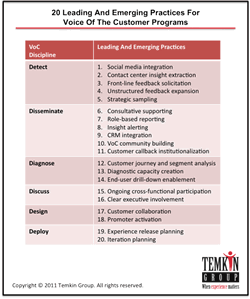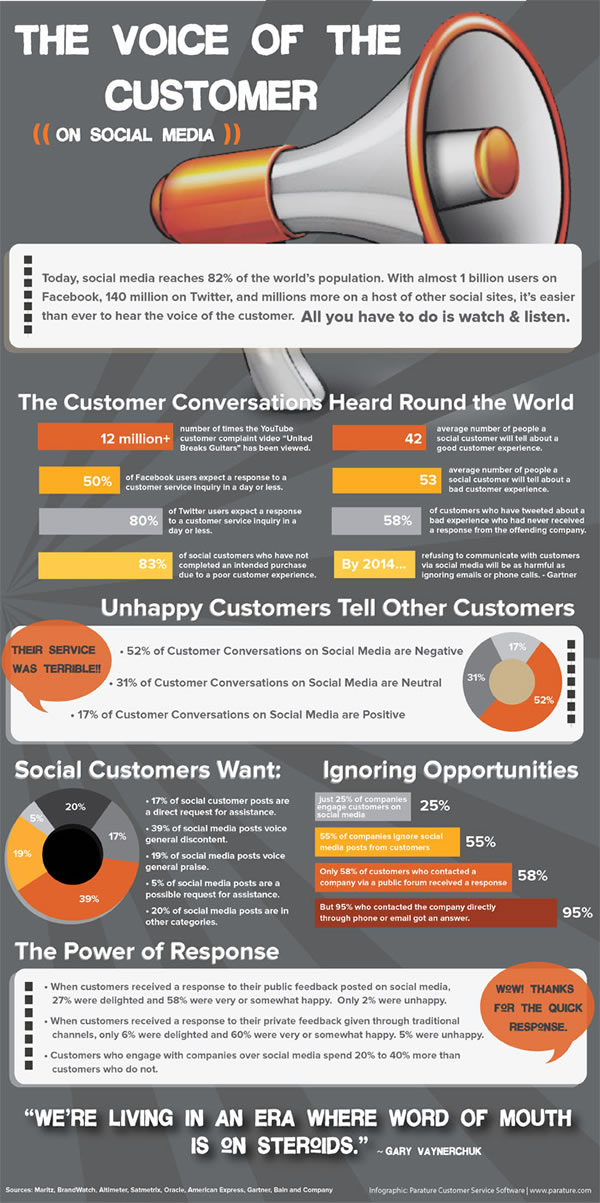Social media and the Voice Of the Customer (VoC). It’s a topic that keeps popping up, especially the value of social and the role of social signals in the overall VoC picture. In its “Integrated Customer Experience study“, Econsultancy once again showed that social media ranks surprisingly low on the list of channels used in a VoC context. Social is even often separated from the overall Voice Of the Customer approach.

This isn’t new. Older research, by MarketTools, showed the disconnect too, even if in 2011 the Temkin Group identified social media as an emerging/leading practice for pretty obvious reasons (click the thumbnail image on the right to see more). In the MarketTool survey, 34% of executives surveyed stated that they were aware of customers using social media to comment on or complain about their company and/or its products. That’s about one-third of respondents. Great, isn’t it? Listening to the voice of the customer should be a channel-agnostic part of integrated marketing, leading to optimization actions across various processes, serving both business goals and customer goals, mainly optimizing the customer experience.
Awareness versus intent and practice
It seems some executives realize that the voice of the customer is channel-agnostic and consumers use social media. However, when looking at how the voice of the customer is taken into account, what customer-centricity is partially about, the outcome is quite shocking, yet not surprising anymore: based on this study the voice of the customer most of the time simply seems not taken into account at all. Less than one-fourth of the executives that were aware customers use social media to comment or complain, said their companies always respond to these customers.
When it boils down to customer service, the research found that 23 percent of companies provide it on Facebook, with 12 percent providing customer service and support via Twitter in that MarketTools survey.
Obviously, a survey is a survey. And, sure, the Voice Of the Customer is just a – be it crucial – part of how social media can be used to interact with customers. And, yes, indeed, social networks are just – again, be it crucial – means that businesses have to gain a single view on what their customers want and need, and to act upon it.
From systematic customer satisfaction surveys and real-life feedback to behavioral analyses, Net Promoter Scores, significance testing or social media sentiment analysis: there are ample ways to understand your customers, their satisfaction levels and the drivers of loyalty. Obviously, this requires an integrated and holistic customer view. However, many businesses simply don’t use them, let alone, systematically optimize their marketing.
Three key actions before starting a voice of the customer program
It’s more important than ever to use several techniques and integrate them within a single information model that can be used across the business.
1. Involve your customer.
However, before doing so, it is crucial that marketers listen to their customers and “bring them in” as Gerry McGovern put it in an interview. That requires a customer-centric mentality change and lots of efforts in the first place. As Gerry says, making it easy for customers, makes it harder for businesses.
2. Break down the silos.
It’s also important to break down the organizational silos (and not only data silos) to understand the pains and degrees of satisfaction of customers. If we look at how businesses deal with marketing optimization, for instance, this is clearly not the case, as Bryan Eisenberg eloquently described it once when writing about “the we-work-in-silos-but-pretend-to-cooperate mentality that produces poor and disconnected experiences for customers”.
3. Learn to listen AND respond.
Finally, and this sounds so obvious, understanding voice of the customer data and actually looking at what customers want – by asking them – is not enough. You also need to respond and act, again across the business and touchpoints. It’s the core of marketing optimization and of customer service on social media, one of the topics in the mentioned survey that clearly indicates companies are missing an opportunity to incorporate social feedback into a voice of the customer program. That shouldn’t come as a real surprise by the way, since many simply miss opportunities in nearly all customer programs.
It is harder and harder to attract customers and keep them. Especially in an economic downturn – and, yes, there is a serious one – customer satisfaction and loyalty, which are always the very core of valuable marketing relationships, are worth more than anything else.
Is firing people and freezing budgets easier than improving the customer experience?
So, it’s quite frustrating to have to read repeatedly that precisely all the methods to improve customer satisfaction and experience, from usability and marketing optimization to social feedback and voice of the customer programs, don’t get the attention they deserve. Apparently, it’s easier to freeze budgets, withdraw campaigns and fire people than to improve the customer experience. Maybe it’s time for those managers, that don’t put the customer central, to see if they wouldn’t better fire themselves before taking other measures in yet another crisis. The customer is key in business: if you don’t integrate his voice, you shouldn’t be in business at all.
Isn’t the survey, one of many similar, nothing more than again proof businesses still don’t pay attention to their customers? It is hard but is it really that hard? Wouldn’t investing more in that instead of only in typical short-term crisis tactics such as sales promotions, pay off more? Would we even have to worry so much about the crisis if we integrated the voice of the customer in the way we do business?
The customer-company landscape has changed and the businesses that will come out on top when the dust settles are the companies that are customer-centric. Customer satisfaction, marketing optimization and voice of the customer programs are critical. First, however, marketers need to listen to their customers – and take action when the “customer voices” require it.
Gather feedback, ask, monitor, watch and integrate. And turn it all into improvements for your customers. The improvements for your business will follow soon and at least remain if you continue doing exactly that, crisis or not and regardless of channels.


